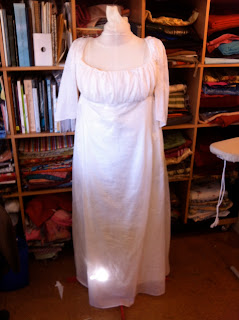I also felt the gown could be a tad ingenue for a women of my 'certain age', but it seems all ages wore them, so who am I to declare that I am of an unsuitable age?
Not only will the gown be white, it is also a sheer muslin, so la, you will be able to see right through it and will be bib fronted, my very first of these as well. I'm using the Hungarian Chicks brilliant tutorial on the bib front gown with the pattern based, loosely, on the one in Janet Arnold's Patterns of Fashion.
This gown is going to be the base for bright shawls, sleeveless spencers and over gowns. It will enable me to 'ring the changes' with the very small wardrobe I can take on the plane to Bath.
I particularly love the sleeveless spencers on the right, they will add colour and difference at the bodice and won't be bulky to pack, unlike four different gown styles.
It is rather exciting working with such sheer fabric, the muslin is so beautifully soft and has a slight sheen.
I cut the gown out two days ago and started sewing today, the Hungarian Chick says that once you get the hang og it, you can whip this gown together in four hours, I'm not as fast as that, but it has been a surprisingly quick project.
So, first, the bodice, which I am pinning closed, rather than using buttons, pins are definitely a period closure and I detest buttonholes, yes I am a coward where they are concerned. I'm also running a thin cord through the bodice neck line to draw it in close with a slight gather, or loosen it off, should I want a lower bodice for evening wear. This is a technique used in the late 18th century gowns and all through the 19th and into the early 20th.
 |
| White on white on white, so very hard to see the bodice front |
 |
| Back bodice, a better pic |
Next I made my bodice bib front, I cut a long strip of muslin on the cross (bias) and then gathered it in to create a lovely ruched effect.
Then I pinned the skirt on to see how it would work
Looking good, I need a few more pleats to compensate for my plump tummy. Next I'll had the sleeves into the bodice and then attach the skirt and beyond metres of hemming, it will be finished, that is indeed quick.
It is rather exciting working with such sheer fabric, the muslin is so beautifully soft and has a slight sheen.
I cut the gown out two days ago and started sewing today, the Hungarian Chick says that once you get the hang og it, you can whip this gown together in four hours, I'm not as fast as that, but it has been a surprisingly quick project.
So, first, the bodice, which I am pinning closed, rather than using buttons, pins are definitely a period closure and I detest buttonholes, yes I am a coward where they are concerned. I'm also running a thin cord through the bodice neck line to draw it in close with a slight gather, or loosen it off, should I want a lower bodice for evening wear. This is a technique used in the late 18th century gowns and all through the 19th and into the early 20th.
 |
| White on white on white, so very hard to see the bodice front |
 |
| Back bodice, a better pic |
Next I made my bodice bib front, I cut a long strip of muslin on the cross (bias) and then gathered it in to create a lovely ruched effect.
Then I pinned the skirt on to see how it would work
Looking good, I need a few more pleats to compensate for my plump tummy. Next I'll had the sleeves into the bodice and then attach the skirt and beyond metres of hemming, it will be finished, that is indeed quick.
 |
| Cutting the facing for the bib front bodice |
 |
| The bib front with bib bodice attached |
The gown is finished, I feel it has turned out very well.
 |
| With bib front down, I gathered my under bodice with ribbon, rather than fitting it and adding buttons, I think it gives more versatility size wise |
 |
| With bib front attached, I didn't pleat the bib front, I prefer a plain front |
 |
| Back of gown showing ties, I haven't stitched on my tie holders as yet |
 |
| Back close-up |
The gown is very transparent, when you consider that most women didn't wear drawers and their chemise and petticoat was equally sheer, hmmm, risque times indeed!
The final product, off to a Regency dinner party with friends.








Ah, so it *was* you I saw at the promenade. I think I have a photo you are in on my blog.
ReplyDeleteI've decided if I go again I definitely need to make a proper spencer.
Sadly I missed you in the parade Lady D, do you attend the ball?
DeleteA spencer is an elegant addition to any lady's wardrobe.
No afraid I couldn't attend the ball. Maybe next year if I save up enough.
DeleteI have a question....how did you finish the 'slit' for the bib front skirt?
ReplyDeleteI was wondering if I could save sewing by just using the side seam as the 'gap' I need (by only sewing up the side seam to half way)?
Yes you can, I did that with my black bib front gown. For this one I followed The Hungarian Chick's blog tutorial and I hemed my slits.
Delete